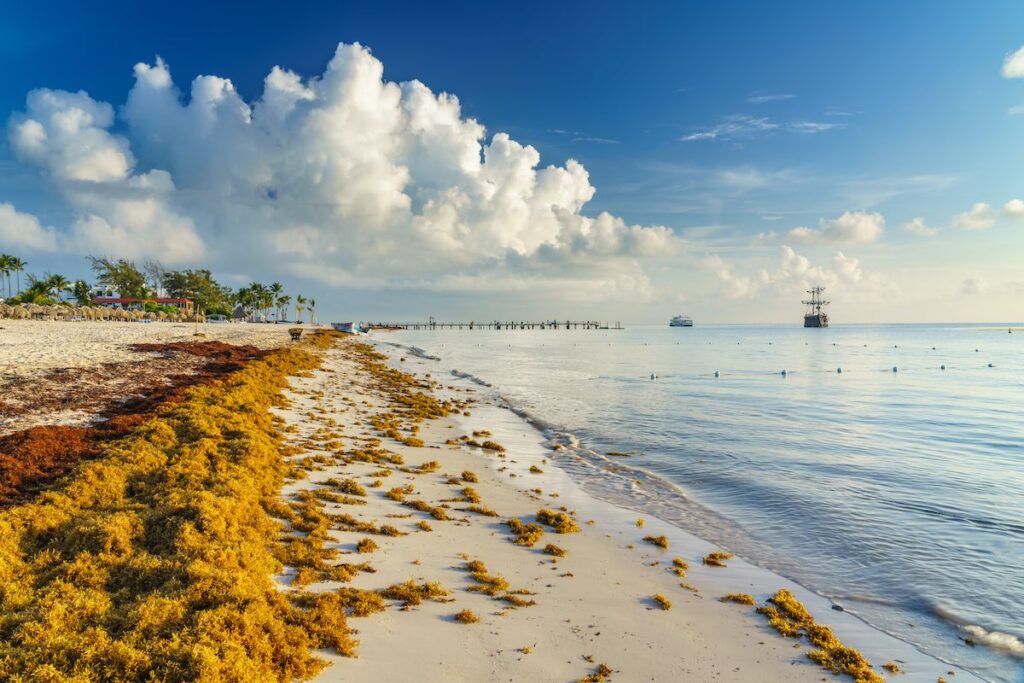No products in the cart.
Travel Guide
Record Amounts Of Seaweed Invading Top Destinations Including Cancun And Puerto Rico
Last Updated
Masses of sargassum seaweed have been invading popular and touristic Caribbean destinations—from Puerto Rico to Barbados— for months, ruining travelers’ vacations and worrying local authorities about economic and environmental consequences.
“This year has been the worst year on record,” said the researcher and faculty member with Florida Sea Grant Lisa Krimsky as reported by the news agency Associated Press (AP).

Krimsky, also Water Resource Regional Specialized Agent based in southeast Florida added: “It is absolutely devastating for the region.”
Over 18.8 million tons in May and over 24 million tons of these brown algae spread across the Atlantic Ocean this year and during July authorities informed that the sargassum keeps arriving non-stop and numbers have not decreased.
This year’s numbers have been considered by the University of South Florida’s Optical Oceanography Lab as “a new historical record” in a report recently published.

Oceanography professor Chuanmin Hu said that according to the data analyzed, the previous record was noted in May 2018 and this year the sargassum levels were higher by 20%. The professor confessed his reaction: “I was scared.”
Over 800 tons of sargassum were collected in June only from Cancun beaches. The different authorities in the Caribbean have been dealing with this problem by applying different strategies to protect local nature and prevent tourism chaos.
What Travelers Should Know About Sargassum

The large brown seaweed is considered harmless to humans but gives off an unpleasant smell —similar to rotten eggs— when it decomposes, covers beautiful sands and pristine waters, and can affect the local ecosystem.
Some people have reported rashes and blisters after being in contact with this seaweed. According to Florida Health’s report, this is caused by sea creatures that live within this algae. So, it’s better to avoid contact with it.

The sargassum creates island-like masses in the ocean that help animals migrate and has an important role in our ecosystem, but it gives off hydrogen sulfide that can irritate the eyes, throat, and nose. Travelers with asthma or other breathing illnesses might be more affected or could have trouble breathing after being exposed to it.
These are general recommendations when visiting a beach with sargassum:
- Avoid touching it.
- Use gloves if you have to handle it.
- Close doors and windows if you are staying near beaches or coasts with sargassum.
- Avoid the beach or staying for too long if you have asthma or respiratory problems.
- Do not cook it or eat it. It is not edible, it can contain metals like arsenic and cadmium.

Another strategy for travelers is to plan their Caribbean vacations during times when they can avoid these algae or consider locations where it doesn’t usually sit.
The best times to visit the Caribbean are between November and March, sargassum’s peak season is usually between May and September.
Top Destinations Dealing With Sargassum

Cancun authorities have assigned local workers to collect sargassum away from there to beaches. Travelers have opted for beaches and locations that do not have these algae like Isla Mujeres or visit spectacular Cenotes around the Quintana Roo state.
In Puerto Rico, local authorities worry about sargassum because they believe that it can affect one of the hottest spots on the island, the bioluminescent bay Fajardo. Tourism kayak companies and the government are studying the sargassum and working on solutions while cleaning it from their coasts.

In Costa Rica, authorities assigned a team to take care of the algae and protect the nesting process of sea turtles. The government also worries about the offshore industry and has been working in collaboration with other nations.
International organizations, including the United Nations, are studying the sargassum, trying to understand why it keeps growing, and working on the best solutions.

Also, different local companies are turning sargassum into new products —from gas to cosmetic products to vegan leather— to use its excess and turn it into innovative solutions.
Read More:
3 Popular Beaches In Mexico Considered Unsafe For Swimming Due To Bacteria
Travel Insurance That Covers Covid-19 For 2022
Digital Nomad Scene In Mexico City Exploding In Popularity
↓ Join the community ↓
The Travel Off Path Community FB group has all the latest reopening news, conversations, and Q&A’s happening daily!

SUBSCRIBE TO OUR LATEST POSTS
Enter your email address to subscribe to Travel Off Path’s latest breaking travel news, straight to your inbox
Disclaimer: Current travel rules and restrictions can change without notice. The decision to travel is ultimately your responsibility. Contact your consulate and/or local authorities to confirm your nationality’s entry and/or any changes to travel requirements before traveling. Travel Off Path does not endorse traveling against government advisories
Source link

